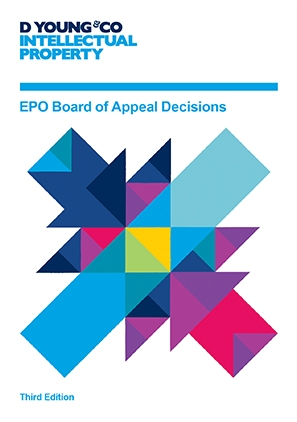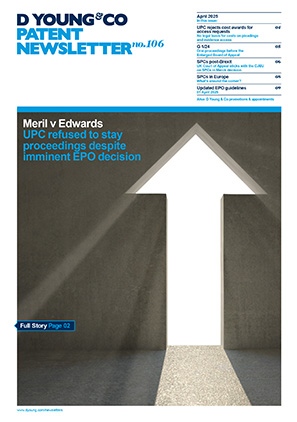Computer implemented inventions in CNIPA and the EPO - recent developments of examination practice
Back in February of 2020, in recognising the rapid growth of the patent filing trend of computer implemented inventions (CIIs) and the expanding role of these new technologies in the Chinese economy, particularly in the fields of AI, Internet+, big data and block chain, the China National Intellectual Property Administration (CNIPA) introduced a whole new section 6 in Part II, Chapter 9 of the Patent Examination Guidelines (2020 Amendment) to provide, for the first time, specific guidance on the examination of patent applications related to these information technologies.
With the 2020 Amendment, CNIPA opened up a new horizon for the examination practice of CII applications. To begin with, the 2020 Amendment explicitly states that any patent claims related to abstract algorithms or business rules, insofar as they contain technical features, shall not be excluded from patent protection under Chinese Patent Law Article 25(2).
Further, claims directed to abstract algorithms or business rules may be regarded as a “technical solution” under Chinese Patent Law Article 2(2), hence eligible for patent protection, provided that the relevant technical means solves a technical problem by utilising the law of the nature.
The 2020 Amendment also introduces a new approach for examining the inventive step of an invention with respect to its algorithm and business rule features. Specifically, algorithm and business rule features having “mutually supportive functions” and an “interactive relationship” with other technical features in a claim shall be considered, in addition to the technical features, when accessing the contributions of the invention to the state of the art.
Case studies of typical CII subject matter such as mathematical models, artificial intelligence (AI), business rules and block chain applications are also discussed in the 2020 Amendment. Six of the examples demonstrate the new examination approach on patentable subject matter and the other four examples explain the inventive step assessment. We will take a more detailed look at some of the examples below.
The 2020 Amendment further sets out the drafting requirements of patent applications involving algorithms and business rules. Most importantly, the specification shall give clear description of the algorithm or business rule features. It shall also describe how a technical problem is solved by the algorithm or business rule features through any mutually supportive functions and interactive relationship with the technical features. The technical benefits shall be described in detail and evidence shall be provided if necessary.
In the case where the technical benefits involve an enhancement of user experience, the enhancement must be objective rather than based on subjective personal preference. The specification shall illustrate how the objective enhancement of user experience is obtained from the mutually supportive functions and an interactive relationship with the technical features of the invention. The mutually supportive functions and an interactive relationship with the technical features shall be clearly recited in the claims.
2021 Draft Amendment to the Examination Guidelines
18 months after the roll out of the 2020 Amendment, the CNIPA issued a 2021 Draft Amendment to the Examination Guidelines (2021 Draft Amendment) on 01 August 2021, with the aim of refining the examination practice for CII applications.
The 2021 Draft Amendment firstly shows approval of two additional claim types for CII applications, namely, computer-readable storage medium claims and computer program product claims, apart from the traditional method claims and device claims. An example related to image noise removal method is provided to demonstrate the various claim drafting styles. This is of great significance to companies as, in many cases, it is the computer program product that is most valuable to them.
Next, the 2021 Draft Amendment proposes specific guidance on examining inventions related to improvement of algorithms for artificial intelligence (such as deep learning, classification and clustering) and big data under Article 2(2) of the Chinese Patent Law, that is, whether a claimed invention falls within the definition of “technical solution”. Where the algorithms have a specific technical relationship with the internal structure of the computer system, the technical problems of how to improve the hardware computing efficiency or execution effect shall be considered, for example, in terms of data storage size, data transmission rate and hardware processing speed. These effects are recognised to be improvements of the internal performance of the computer system which conform to the laws of nature.
If the improvement of an invention lies in the application of big data instead of the algorithm, the 2021 Draft Amendment suggests that data processing means such as classification, clustering, regression analysis, and neural network for data mining, which solves technical problems concerning the reliability and accuracy of big data analysis, would conform to the laws of nature with respect to the intrinsic correlation of the data.
According to the 2021 Draft Amendment, when assessing an inventive step of a “mixed-type invention” involving algorithm features, the specific technical relationship between the algorithm features and the internal structure of the computer system shall be examined. If the technical relationship improves the internal performance of the computer system, and enhances the computing efficiency or execution effect of the hardware, for example, in terms of data storage size, data transmission rate and hardware processing speed, the examiner may determine that the algorithm features “have mutually supportive functions” and an “interactive relationship” with the technical features, hence contributing to the inventive step of the invention.
The 2021 Draft Amendment also elaborates on the approach for examining inventions which enhance user experiences. If the enhancement of user experience is produced by technical features in collaboration with algorithm features or business rules, such that the claim features as a whole have mutually supportive functions and an interactive relationship, the contribution of these algorithm features or business rules shall also be considered when accessing inventive step.
Five new case studies have been added by the 2021 Draft Amendment, including four examples for examining patent eligibility and one example on inventive step assessment. In addition, the reasoning related to enhancement of user experience for the previous example on “logistics distribution” invention has been updated.
| Subject matter of invention | Category | Assessment of CNIPA | |
|---|---|---|---|
| 1 | Building a mathematical model | Algorithm | Non-patentable subject matter |
| 2 | Training a convolutional neural network (CNN) model | Algorithm | Patentable subject matter |
| 3 | Use of shared bicycles | Business rule | Patentable subject matter |
| 4 | Communication between nodes of block chain | Business rule | Patentable subject matter |
| 5 | A training method of deep neural network model | Algorithm | Patentable subject matter |
| 6 | An analysis method of e-voucher usage tendency | Business rule | Patentable subject matter |
| 7 | A Knowledge Graph Reasoning Method | Algorithm | Patentable subject matter |
| 8 | Rebating for spending | Business rule | Non-patentable subject matter |
| 9 | Analysis of an economic sentiment index based on electricity consumption characteristics | Business rule | Non-patentable subject matter |
| 10 | A price prediction method for financial products | Business rule | Non-patentable subject matter |
| 11 | Detecting falling state of humanoid robot based on multi-sensor information | Algorithm | Involves an inventive step |
| 12 | Planning multiple robot paths based on cooperative co-evolution and multi-group genetic algorithm | Algorithm | Lacks an inventive step |
| 13 | Logistics distribution method | Business rule | Involves an inventive step |
| 14 | Visualization of dynamic viewpoint evolution | Business rule | Lacks an inventive step |
| 15 | A method for adapting neural network parameters | Algorithm | Involves an inventive step |
* Entries 5, 6, 7, 10, and 15 in the above table are new examples in the 2021 Draft Amendment.
Most of the new examples have relatively clear facts regarding technical and non-technical features which draw the boundary between patentable and non-patentable claims, for instance, a knowledge graph reasoning method that enriches semantic information and improves the accuracy of reasoning in the process of text embedding and semantic search; and a method for adapting neural network parameters to make the hardware efficiently perform the calculations in the neural network.
The more interesting case studies are those allowable cases which involve a business purpose. In the “logistics distribution method” case previously described in the 2020 Amendment, the business rules regarding pickup notifications and the technical arrangement of sending batch notifications are considered to have mutually supportive functions and an interactive relationship, which jointly improve the efficiency of order arrival notification and thus the efficiency of goods distribution. The 2021 Draft Amendment further elaborates on the reasoning that the business rule features and technical features allow the operation of the logistics dispatcher to become more convenient. The customer can receive the pick-up notice more timely, thereby enhancing the user experience of the pick-up and delivery parties. It is noteworthy that the 2021 Draft Amendment explicitly recognises that the user experience improvement and the technical effects both constitute the beneficial effects of the invention in comparison with the prior art.
The 2021 Draft Amendment further provides a new case study in relation to an analysis method of e-voucher usage tendency. The invention constructs an e-voucher usage tendency recognition model which can more accurately determine the customer's preference for e-vouchers. In particular, by categorising e-vouchers, obtaining sample data, determining behaviour characteristics, and performing model training, mining the inherent relationship between user behaviour characteristics and e-voucher usage tendency, the invention enables the issuance of e-vouchers to better meet the actual needs of the users and increases the utilisation rate of e-vouchers. Behaviour characteristics such as long browsing time, frequent searches, and frequent uses of e-vouchers may reflect a high tendency to use corresponding types of e-vouchers. The 2021 Draft Amendment suggests that “this internal relationship is consistent with the laws of nature” and arrives at the conclusion that the invention solves the technical problem of how to improve the accuracy of analysing the user's tendency to use e-vouchers, thereby a technical effect is obtained.
Comparing the Chinese and European approaches
The China examination practice for CII applications as discussed above will now be compared with the latest EPO approach. We will also try to access some of the examples in the 2021 Draft Amendment from the EPO perspective and compare the expected outcomes.
First of all, we need to consider the general flow of substantive examination in the two patent offices. The examination of patentability in EPO generally adopts a “two-hurdle” approach (as confirmed by recent case law G1/19). In a nutshell, the examiner will first consider whether the claimed invention falls within the categories of non-patentable subject matter, such as scientific discovery, mental acts, computer program as such. Only if the claimed invention is not an excluded matter, the examiner will proceed to examine the novelty and inventive step criteria.
On the other hand, CNIPA takes a “three-hurdle” approach with the first hurdle similar to the EPO approach, in which the claims are checked against a list of excluded matter. Nevertheless, at the CNIPA, there is a second hurdle before proceeding to novelty and inventive step assessment, where the examiner will ask whether the claimed invention qualifies as a “technical solution” that adopts technical means to solve a technical problem and thereby achieves any technical effect. This is because Chinese patent law provides a positive definition of what constitute an “invention” under Article 2(2); a provision that is lacking in the European Patent Convention (EPC). At the EPO, established case-law means that claims containing technical and non-technical features are only rejected under the EPO’s second hurdle where the novelty and inventive step of the subject matter is examined.
Accordingly, as there is no equivalent to the CNIPA’s second hurdle at the EPO, it is not possible to give any comments from the European perspective on the changes in the 2021 Draft Amendment concerning the examination of CII applications at the CNIPA under Article 2(2) and we will instead focus on the inventive step assessment in the third hurdle.
The guidance on examining the inventive step of “mixed type inventions” is provided in EPO Guidelines G-VII, 5.4. In fact, the EPO shares a very similar approach as that adopted by the CNIPA. Generally speaking, the presence of an inventive step requires a non-obvious technical solution to a technical problem. For claims comprising technical and non-technical features, both technical and non-technical features of the “mixed type invention”, as long as they “contribute to the technical character of the invention”, are taken into account when accessing the inventive step. “Contributing to the technical character of the invention” means contributing to the solution of a technical problem, producing a technical effect and serving a technical purpose. If a feature contributes only to the solution of a non-technical problem (such as a problem in a field of an excluded matter), it cannot support the presence of an inventive step. Examples of technical purposes which may be served by a mathematical method, artificial intelligence or machine learning (ML) are given in the list under EPO Guidelines G-II, 3.3.
In the case where the non-technical features do not contribute to the technical character of the invention, they may still be used in the formulation of the objective technical problem as part of what is “given” to the skilled person, in particular, as a constraint that has to be met. A common example is how to modify a conventional method to implement a non-technical business concept in a technically efficient manner.
In most cases, the CNIPA and EPO are in alignment, for example, non-technical features that contribute to the technical character of the invention under the EPO approach appear to also have mutually supportive functions and an interactive relationship with other technical features based on the CNIPA benchmark. Nevertheless, in the CNIPA Guidelines logistics distribution example, user experience improvement achieved by a more convenient operation of the logistics dispatcher and a timely pick-up notice are unlikely to be considered as technical effects under EPO practice. The business rule features are unlikely to be regarded as contributing to the technical character and therefore would not support the presence of an inventive step.
In another CNIPA Guidelines example related to e-vouchers, whether the EPO would consider the behaviour characteristics of consumers as technical feature is questionable since it involves cognitive, conceptual or intellectual processes in the human mind (schemes, rules and methods for performing mental acts). The purpose of improving the accuracy of analysing the user's tendency to use e-vouchers is therefore arguably a business purpose which would not contribute to an inventive step. Inventions targeting on user experience improvement (which are quite typical for CII) are therefore more likely to be allowed by the CNIPA.
Conclusion
With the refined approach for examining “mixed type inventions” set out in the 2020 Guidelines Amendment and the 2021 Draft Guidelines Amendment, it is believed that the CNIPA will be able to harmonise and streamline the examination practice for CII applications with respect to the EPO approach, especially on the evaluation of inventive step of “mixed type inventions”. This will in turn strengthen further collaborations between the two patent offices, such as the CNIPA-EPO pilot programme launched on 01 December 2020, in which international applications with CNIPA as the receiving office can select the EPO as an international search authority for conducting patent searches and providing opinions on novelty and inventive step. Having said that, according to the foregoing analysis on the 2021 Draft Amendment, it seems that the two patent offices have certain deviations with the approach of accessing the invention step of “mixed-type inventions” and the CNIPA appears to have a lower bar in accepting the contribution of non-technical features. This observation is subject to the final release of the 2021 Guidelines Amendment and we will keep an eye on the latest development in China.


